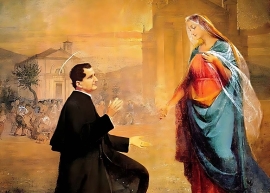In introducing the dream, Don Bosco's biographer, Fr Giovanni Battista Lemoyne, starts from an episode that occurred years earlier: “In February 1848, the Marquis Roberto d 'Azeglio, a personal friend of Carlo Alberto and senator of the Kingdom, honoured Don Bosco's Oratory with a visit. The Saint accompanied him in visiting the whole house. The Marquis expressed his real pleasure, but with one reservation: he described time lost as time spent saying the Rosary.
“No need” he said, “to say those old-fashioned 50 Hail Marys strung one after the other.”
“Well” Don Bosco replied, “I care very much about this practice; and I could say that my institution is founded on this; I would be willing to leave many other important things aside, but not this one." And with his typical courage he added: "And even if it were necessary, I would be willing to renounce your valuable friendship, but never saying the Holy Rosary.”
Therefore, Fr Lemoyne continues with the description of the dream:
He was also encouraged by his dreams to encourage young people to love the Rosary. Let's mention one. He had it on the eve of the Assumption 1862. He dreamed of being in his native village – today Colle Don Bosco - in his brother's house, with all his boys. And up came a stranger (the usual Guide of his dreams) who invites him to go to the lawn next to the courtyard, and there he showed him a snake 7-8 metres long, of extraordinary thickness. Don Bosco was horrified and wanted to escape. But the Guide invited him not to be afraid and to stay put. Then he went to get a rope, returned to Don Bosco and said:
“Take this end,” he said on his return, “and grip it tightly with both hands. I'll hold the other, and we'll let it dangle over the snake.”
“And then?”
“Then we'll snap it across its back.”
“You must be crazy! The snake will leap up and tear us to pieces.”
“But the stranger insisted” Don Bosco narrates “and once more assured me that I had nothing to fear because the snake would do me no harm. He talked so persuasively that I stayed on and agreed to his plan. We stretched the rope and then snapped it across the snake's back. The monster immediately sprang up and struck at the rope, but, as it did so, it ensnared itself as in a noose."
"Hold on" the stranger shouted “Don't let go!”
He ran to a nearby pear tree and tied his end of the rope to it. Then he came to me and tied my end to the iron grating of a window in the house. The snake kept furiously struggling to free itself, writhing, thrashing, and flailing about. In its fury it tore itself to pieces, scattering its flesh over the area, till it was slashed to a mere skeleton.
The stranger then untied the rope and coiled it up. “Now watch very carefully!” he said as he put it into a box and closed it. Within a few moments he opened the box. We looked in and were astounded to see the rope shaped into the words “Ave Maria”.
“The snake,” the man replied, “is a symbol of the devil, whereas the rope stands for Ave, Maria or, rather, the rosary, a succession of Hail Marys with which we can strike, conquer, and destroy all of hell's demons.”
At this point, Don Bosco saw a very painful scene: he saw young people who collected pieces of snake flesh and ate it and were poisoned.
“I was helpless because, despite this, more and more boys kept eating that meat. I shouted and yelled at them, and even slapped and punched them to keep them from eating, but in vain. I shouted at one, I shouted at the other; I slapped this one, punched that one, trying to prevent them from eating, but to no avail. Nearly out of my mind at seeing so many boys lying about me in such a pitiful state, I turned to the stranger.
“But isn't there some way of saving these boys?”
“Yes, there is”.
“What?”
“Anvil and hammer”.
“What for?” “You mean I am to put them on an anvil and strike them with a hammer?”
“Look," the stranger said “this whole thing is a symbol. The hammer symbolizes confession, and the anvil symbolizes Holy Communion. These are the remedies you must use."


